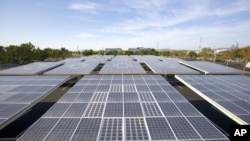The Obama administration says it's not backing away the President's pledge to cut emissions by 17 percent, despite the Senate's rejection of such a measure.
Among the differences between the White House and Capitol Hill, the Senate’s most recent version of climate change legislation does not include caps for carbon emissions. However, it does offer incentives for consumers to make their cars and homes more energy efficient.
Bill Murray is an analyst with Energy Intelligence. He says tax breaks and subsidies for new technology is nothing new. As a matter of fact, he says, that's exactly what got coal, oil and gas companies off the ground more than a century ago.
"Back in the day, back in the 19th century when they were starting, there were all different kinds of government ways to help out these very small and start-up industries," says Murray. "Now you have wind and solar energy start-ups for what we would consider alternative energy. But it's a common practice for governments for the past many decades to actually target certain industries that they want to support."
Solar panels in the Southwest or wind turbines off the coast of Massachusetts may be part of the solution to curbing greenhouse gas emissions. But Murray says to send that power to other places where the demand is high, such as California, Texas or the Northeast, will take what he calls a "smart grid."
"Smart grid is really a term that means digitizing the electrical grid. Right now it is very much analog. You know, Thomas Edison would recognize the technology," Murray notes. "Once you are able to digitize it, able to have it work essentially like we would expect an Internet to work, talking at the speed of light, then you are actually able to move these electrons from East Coast to the middle of the country or from the Southwest to other parts."
Such a smart grid would require massive investment in the US infrastructure, perhaps totaling in the trillions of dollars in time. Such investments during an economic downturn are unlikely, so Murray says the Obama administration is taking a different route.
"What the Obama administration has done, and other people around the world especially in China are doing, is funding a smart grid for an infrastructure that can then handle solar power that would be not from companies necessarily, but just from individual homes."
Companies like Google with major electrical needs and individual homeowners are adding solar power or wind turbines to their properties to perhaps help cut down on carbon emissions. But there's also a cost-cutting benefit to hooking up your hot water heater or air conditioning unit to a solar panel. Initial costs can be expensive: the retail home improvement company Home Depot sells a 123-watt solar panel kit for more than $8500 dollars. Murray says tax benefits are one of the reasons some people are able to install their own supplemental sources of power.
"The costs will come down over time, but it has to be sustained," says Murray. "In the late 1970s, the technology was not as advanced, and the subsidies and tax benefits for individuals and companies disappeared. And once that disappears, people are going to have a tough time justifying it for themselves."
You'll find many more stories on the economy and the environment at VOA's Going Green site.





